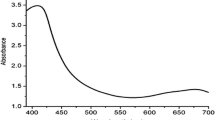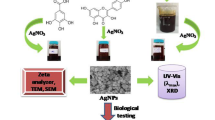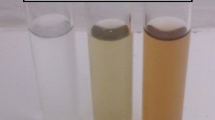Abstract
Phytochemical substances in seaweeds have a wide range of pharmacological properties and are involved in a unique eco-friendly technique to produce stable, less harmful metal nanoparticles. The antioxidant-rich phytochemical elements in red seaweed Champia parvula extract have garnered attention for their potential functions in the prevention of human diseases. This research explores the phytoconstituent contents of C. parvula aqueous extract as well as its ability to synthesize silver nanoparticles, and its antioxidant, antimicrobial, and anticancer properties are investigated. The seaweed extract was analyzed for total phenols (2.02 ± 0.11 mg/g), flavonoids (1.72 ± 0.05 mg/g), tannins (1.55 ± mg/g), anthocyanin (0.79 ± 0.21 mg/g), and total chlorophyll (0.7 ± 0.04 mg/g) contents. The biosynthesized C. parvula-mediated silver nanoparticles (Cp-AgNPs) were characterized by various spectroscopic techniques. The surface plasmonic resonance (SPR) band of Cp-AgNPs was observed at 425 nm using UV spectroscopy. The face-centered cubic (FCC) and crystalline structure were identified by X-ray diffraction (XRD) analysis. Scanning electron microscopy (SEM) confirmed the morphology of Cp-AgNPs as round in shape with 79 nm size. The biomolecules in the algae extract and Cp-AgNPs were identified with the help of FT-IR analysis, which confirms the presence of phenolic, proteins and amine compounds. Zeta potential analysis proved that the biosynthesized Cp-AgNPs were extremely stable due to the surface charge of nanoparticles (− 35.2 mV). The Cp-AgNPs showed greater free radical scavenging ability due to the presence of bioactive molecules such as phenols, flavonoids, tannins, and anthocyanin in algae extract. Cp-AgNPs exhibited the highest antimicrobial activity against Streptococcus mutans, Staphylococcus aureus, and Candida albicans at 100 μg/mL. Furthermore, Cp-AgNPs demonstrated anticancer activity against human lung (A549) cancer and colon (HT-29) cancer cells. The half-maximal inhibitory for lung cancer was found at 21.54 μg/mL, and for colon cancer it was found at 42.36 μg/mL. These findings confirmed that the synthesized Cp-AgNPs have a wide range of pharmacological activities and might be used as target drug carriers.
















Similar content being viewed by others
Data Availability
The authors confirm that the data supporting the findings of this study are available within the article.
References
Almalki MA, Khalifa AY (2020) Silver nanoparticles synthesis from Bacillus sp KFU36 and its anticancer effect in breast cancer MCF-7 cells via induction of apoptotic mechanism. J Photochem Photobiol B Biol 204:111786. https://doi.org/10.1016/j.jphotobiol.2020.111786
Hamouda RA, Hussein MH, Abo-Elmagd RA, Bawazir SS (2019) Synthesis and biological characterization of silver nanoparticles derived from the cyanobacterium Oscillatoria limnetica. Sci Rep 9(1):1–17. https://doi.org/10.1038/s41598-019-49444-y
Mussin J, Robles-Botero V, Casañas-Pimentel R, Rojas F, Angiolella L, Martín-Martínez S, Giusiano G (2021) Antimicrobial and cytotoxic activity of green synthesis silver nanoparticles targeting skin and soft tissue infectious agents. Sci Rep 11(1):1–12. https://doi.org/10.1038/s41598-021-94012-y
Alsubki R, Tabassum H, Abudawood M, Rabaan AA, Alsobaie SF, Ansar S (2021) Green synthesis, characterization, enhanced functionality and biological evaluation of silver nanoparticles based on Coriander sativum. Saudi J Biol Sci 28(4):2102–2108. https://doi.org/10.1016/j.sjbs.2020.12.055
Pallavi SS, Rudayni HA, Bepari A, Niazi SK, Nayaka S (2022) Green synthesis of silver nanoparticles using Streptomyces hirsutus strain SNPGA-8 and their characterization, antimicrobial activity, and anticancer activity against human lung carcinoma cell line A549. Saudi J Biol Sci 29(1):228–238. https://doi.org/10.1016/j.sjbs.2021.08.084
Wei L, Lu J, Xu H, Patel A, Chen ZS, Chen G (2015) Silver nanoparticles: synthesis, properties, and therapeutic applications. Drug Discov Today 20(5):595–601. https://doi.org/10.1016/j.drudis.2014.11.014
Ghannam A, Murad H, Jazzara M, Odeh A, Allaf AW (2018) Isolation, structural characterization, and antiproliferative activity of phycocolloids from the red seaweed Laurencia papillosa on MCF-7 human breast cancer cells. Int J Biol Macromol 108:916–926. https://doi.org/10.1016/j.ijbiomac.2017.11.001
Balaraman P, Balasubramanian B, Kaliannan D, Durai M, Kamyab H, Park S, Chelliapan S, Lee CT, Maluventhen V, Maruthupandian A (2020) Phyco-synthesis of silver nanoparticles mediated from marine algae Sargassum myriocystum and its potential biological and environmental applications. Waste Biomass Valorization 11(10):5255–5271. https://doi.org/10.1007/s12649-020-01083-5
Fawcett D, Verduin JJ, Shah M, Sharma SB, Poinern GEJ (2017) A review of current research into the biogenic synthesis of metal and metal oxide nanoparticles via marine algae and seagrasses. J Nanosci 2017:1–15. https://doi.org/10.1155/2017/8013850
Khalifa SA, Elias N, Farag MA, Chen L, Saeed A, Hegazy MEF, Moustafa MS, Abd El-Wahed A, Al-Mousawi SM, Musharraf SG, Chang FR (2019) Marine natural products: a source of novel anticancer drugs. Mar Drugs 17(9):491. https://doi.org/10.3390/md17090491
Santhanam, R., Santhanam, R. and Suleria, H., 2018. Biology and Ecology of Pharmaceutical Marine Plants (1st ed). CRC Press. https://doi.org/10.1201/9781351187114
Yogarajalakshmi P, Poonguzhali TV, Ganesan R, Karthi S, Senthil-Nathan S, Krutmuang P, Radhakrishnan N, Mohammad F, Kim TJ, Vasantha-Srinivasan P (2020) Toxicological screening of marine red algae Champia parvula (C. Agardh) against the dengue mosquito vector Aedes aegypti (Linn.) and its non-toxicity against three beneficial aquatic predators. Aquat Toxicol 222:105474. https://doi.org/10.1016/j.aquatox.2020.105474
Viswanathan S, Palaniyandi T, Kannaki P, Shanmugam R, Baskar G, Rahaman AM, Paul LTD, Rajendran BK, Sivaji A (2022) Biogenic synthesis of gold nanoparticles using red seaweed Champia parvula and its anti-oxidant and anticarcinogenic activity on lung cancer. Part Sci Technol 1–9. https://doi.org/10.1080/02726351.2022.2074926
Sandhiya V, Thirunavukkarasu P, Gomathy B, Sridhar M, Rajeshkumar S, Ravi M, Asha S (2021) Agnp-Hp synthesized using red marine algae Halymenia pseudofloresii and its pharmacological activities. Ann Rom Soci for Cell Biol 25(6):19433–19450. https://annalsofrscb.ro/index.php/journal/article/view/9758
Tavakol S, Hoveizi E, Kharrazi S, Tavakol B, Karimi S, Rezayat Sorkhabadi SM (2017) Organelles and chromatin fragmentation of human umbilical vein endothelial cell influence by the effects of zeta potential and size of silver nanoparticles in different manners. Artif Cells, Nanomed, Biotechnol 45(4):817–823. https://doi.org/10.1080/21691401.2016.1178132
Chang CC, Yang MH, Wen HM, Chern JC (2002) Estimation of total flavonoid content in propolis by two complementary colorimetric methods. J Food Drug Anal 10(3):178–182. https://doi.org/10.38212/2224-6614.2748
Julkunen-Tiitto R (1985) Phenolic constituents in the leaves of northern willows: methods for the analysis of certain phenolics. J Agric Food Chem 33(2):213–217. https://doi.org/10.1021/jf00062a013
Ling ALM, Yasir S, Matanjun P, Abu Bakar MF (2015) Effect of different drying techniques on the phytochemical content and antioxidant activity of Kappaphycus alvarezii. J Appl Phycol 27(4):1717–1723. https://doi.org/10.1007/s10811-014-0467-3
El-Din SMM, El-Ahwany AM (2016) Bioactivity and phytochemical constituents of marine red seaweeds (Jania rubens, Corallina mediterranea and Pterocladia capillacea). J Taibah Univ Sci 10(4):471–484. https://doi.org/10.1016/j.jtusci.2015.06.004
Trivedi S, Alshehri MA, Panneerselvam C, Al-Aoh HA, Maggi F, Sut S, Dall’Acqua S (2021) Insecticidal, antibacterial and dye adsorbent properties of Sargassum muticum decorated nano-silver particles. S Afr J Bot 139:432–441. https://doi.org/10.1016/j.sajb.2021.03.002
Sandhiya V, Gomathy B, Sivasankaran MR, Thirunavukkarasu P, Mugip Rahaman A, Asha S (2021) Green synthesis of silver nanoparticles from guava (Psidium guajava Linn.) leaf for antibacterial, antioxidant and cytotoxic activity on HT-29 cells (Colon cancer). Ann Romanian Soc for Cell Biol 25(6):20148–20163. https://www.annalsofrscb.ro/index.php/journal/article/view/10001
Hulikere MM, Joshi CG (2019) Characterization, antioxidant and antimicrobial activity of silver nanoparticles synthesized using marine endophytic fungus-Cladosporium cladosporioides. Process Biochem 82:199–204. https://doi.org/10.1016/j.procbio.2019.04.011
Viswanathan S, Palaniyandi T, Shanmugam R, Rajendran BK, Sivaji A (2022) Biomedical potential of silver nanoparticles capped with active ingredients of Hypnea valentiae, red algae species. Part Sci Technol 40(6):686–696. https://doi.org/10.1080/02726351.2021.1992059
Vinoth Kumar R, Murugesan S, Bhuvaneswari S (2015) Phytochemical analysis of red alga Champia parvula (C. Agardh) collected from Mandapam coast of Tamil Nadu, India. Int J Adv Pharm 4(3):15–20. https://doi.org/10.7439/ijap.v4i3.2352
Makarov VV, Love AJ, Sinitsyna OV, Makarova SS, Yaminsky IV, Taliansky ME, Kalinina NO (2014) “Green” nanotechnologies: synthesis of metal nanoparticles using plants. Acta Naturae (англоязычная версия) 6(1 (20)):35–44 https://www.ncbi.nlm.nih.gov/pmc/articles/PMC3999464/
de Aragao AP, de Oliveira TM, Quelemes PV, Perfeito MLG, Araujo MC, Santiago JDAS, Cardoso VS, Quaresma P, de Almeida JRDS, da Silva DA (2019) Green synthesis of silver nanoparticles using the seaweed Gracilaria birdiae and their antibacterial activity. Arab J Chem 12(8):4182–4188. https://doi.org/10.1016/j.arabjc.2016.04.014
Ghareeb RY, Shams El-Din NGED, Maghraby DME, Ibrahim DS, Abdel-Megeed A, Abdelsalam NR (2022) Nematicidal activity of seaweed-synthesized silver nanoparticles and extracts against Meloidogyne incognita on tomato plants. Sci Rep 12(1):1–16. https://doi.org/10.1038/s41598-022-06600-1
Dixit D, Gangadharan D, Popat KM, Reddy CRK, Trivedi M, Gadhavi DK (2018) Synthesis, characterization and application of green seaweed mediated silver nanoparticles (AgNPs) as antibacterial agents for water disinfection. Water Sci Technol 78(1):235–246. https://doi.org/10.2166/wst.2018.292
Yousefzadi M, Rahimi Z, Ghafori V (2014) The green synthesis, characterization and antimicrobial activities of silver nanoparticles synthesized from green alga Enteromorpha flexuosa (wulfen). J Agardh Mater Lett 137:1–4. https://doi.org/10.1016/j.matlet.2014.08.110
Rajeshkumar S, Bharath LV (2017) Mechanism of plant-mediated synthesis of silver nanoparticles–a review on biomolecules involved, characterisation and antibacterial activity. Chem Biol Interact 273:219–227. https://doi.org/10.1016/j.cbi.2017.06.019
Ahmad S, Munir S, Zeb N, Ullah A, Khan B, Ali J, Bilal M, Omer M, Alamzeb M, Salman SM, Ali S (2019) Green nanotechnology: a review on green synthesis of silver nanoparticles—an ecofriendly approach. Int J Nanomed 14:5087. https://doi.org/10.2147/IJN.S200254
El-Rafie HM, El-Rafie M, Zahran MK (2013) Green synthesis of silver nanoparticles using polysaccharides extracted from marine macro algae. Carbohydr Polym 96(2):403–410. https://doi.org/10.1016/j.carbpol.2013.03.071
Massironi A, Morelli A, Grassi L, Puppi D, Braccini S, Maisetta G, Esin S, Batoni G, Della Pina C, Chiellini F (2019) Ulvan as novel reducing and stabilizing agent from renewable algal biomass: application to green synthesis of silver nanoparticles. Carbohydr Polym 203:310–321. https://doi.org/10.1016/j.carbpol.2018.09.066
Negm MA, Ibrahim HA, Shaltout NA, Shawky HA, Abdel-Mottaleb MS, Hamdona SK (2018) Green synthesis of silver nanoparticles using marine algae extract and their antibacterial activity. Sciences 8(03):957–970. https://www.academia.edu/download/84247596/957-970.pdf
Dubau L, Lopez-Haro M, Castanheira L, Durst J, Chatenet M, Bayle-Guillemaud P, Guétaz L, Caqué N, Rossinot E, Maillard F (2013) Probing the structure, the composition and the ORR activity of Pt3Co/C nanocrystallites during a 3422 h PEMFC ageing test. Appl Catal B Environ 142:801–808. https://doi.org/10.1016/j.apcatb.2013.06.011
Abdi V, Sourinejad I, Yousefzadi M, Ghasemi Z (2018) Mangrove-mediated synthesis of silver nanoparticles using native Avicennia marina plant extract from southern Iran. Chem Eng Commun 205(8):1069–1076. https://doi.org/10.1080/00986445.2018.1431624
Bhuyar P, Rahim MHA, Sundararaju S, Ramaraj R, Maniam GP, Govindan N (2020) Synthesis of silver nanoparticles using marine macroalgae Padina sp. and its antibacterial activity towards pathogenic bacteria. Beni-Suef Univ J Basic Appl Sci 9(1):1–15. https://doi.org/10.1186/s43088-019-0031-y
Kedi PBE, Meva FEA, Kotsedi L, Nguemfo EL, Zangueu CB, Ntoumba AA, Mohamed HEA, Dongmo AB, Maaza M (2018) Eco-friendly synthesis, characterization, in vitro and in vivo anti-inflammatory activity of silver nanoparticle-mediated Selaginella myosurus aqueous extract. Int J Nanomed 13:8537. https://doi.org/10.2147/IJN.S174530
Balaji DS, Basavaraja S, Deshpande R, Mahesh DB, Prabhakar BK, Venkataraman A (2009) Extracellular biosynthesis of functionalized silver nanoparticles by strains of Cladosporium cladosporioides fungus. Colloids Surf B: Biointerfaces 68(1):88–92. https://doi.org/10.1016/j.colsurfb.2008.09.022
Arunkumar K, Sivakumar SR, Rengasamy R (2010) Review on bioactive potential in seaweeds (marine macroalgae): a special emphasis on bioactivity of seaweeds against plant pathogens. Asian J Plant Sci 9(5):227–242. https://agris.fao.org/agris-search/search.do?recordID=DJ2012059858
Fatima R, Priya M, Indurthi L, Radhakrishnan V, Sudhakaran R (2020) Biosynthesis of silver nanoparticles using red algae Portieria hornemannii and its antibacterial activity against fish pathogens. Microb Pathog 138:103780. https://doi.org/10.1016/j.micpath.2019.103780
Liguori I, Russo G, Curcio F, Bulli G, Aran L, Della-Morte D, Gargiulo G, Testa G, Cacciatore F, Bonaduce D, Abete P (2018) Oxidative stress, aging, and diseases. Clin Interv Aging 13:757
Bhakya S, Muthukrishnan S, Sukumaran M, Muthukumar M (2016) Biogenic synthesis of silver nanoparticles and their antioxidant and antibacterial activity. Appl Nanosci 6(5):755–766. https://doi.org/10.1007/s13204-015-0473-z
Palanisamy S, Rajasekar P, Vijayaprasath G, Ravi G, Manikandan R, Prabhu NM (2017) A green route to synthesis silver nanoparticles using Sargassum polycystum and its antioxidant and cytotoxic effects: an in vitro analysis. Mater Lett 189:196–200. https://doi.org/10.1016/j.matlet.2016.12.005
Govindan, P., Murugan, M., Pitchaikani, S., Venkatachalam, P., Gopalakrishnan, A.V., Kandasamy, S. and Shakila, H., 2021. Synthesis and characterization of bioactive silver nanoparticles from red marine macroalgae Chondrococcus hornemannii. Materials Today: Proceedings.pp. 1-9. https://doi.org/10.1016/j.matpr.2021.02.497
Yang EJ, Kim S, Kim JS, Choi IH (2012) Inflammasome formation and IL-1β release by human blood monocytes in response to silver nanoparticles. Biomaterials 33(28):6858–6867. https://doi.org/10.1016/j.biomaterials.2012.06.016
Gnanakani PE, Santhanam P, Premkumar K, Kumar KE, Dhanaraju MD (2019) Nannochloropsis extract–mediated synthesis of biogenic silver nanoparticles, characterization and in vitro assessment of antimicrobial, antioxidant and cytotoxic activities. Asian Pac J Cancer Prev: apjcp 20(8):2353
Govindappa M, Hemashekhar B, Arthikala MK, Rai VR, Ramachandra YL (2018) Characterization, antibacterial, antioxidant, antidiabetic, anti-inflammatory and antityrosinase activity of green synthesized silver nanoparticles using Calophyllum tomentosum leaves extract. Results in Phys 9:400–408. https://doi.org/10.1016/j.rinp.2018.02.049
Shahidi F, Zhong Y (2015) Measurement of antioxidant activity. J Funct Foods 18:757–781. https://doi.org/10.1016/j.jff.2015.01.047
Mahendiran D, Subash G, Arumai Selvan D, Rehana D, Senthil Kumar R, Kalilur Rahiman A (2017) Biosynthesis of zinc oxide nanoparticles using plant extracts of Aloe vera and Hibiscus sabdariffa: phytochemical, antibacterial, antioxidant and anti-proliferative studies. BioNanoSci 7(3):530–545. https://doi.org/10.1007/s12668-017-0418-y
Kavaz D, Huzaifa UMAR, ZİMUTO, T. (2019) Biosynthesis of gold nanoparticles using Scytosiphon lomentaria (brown algae) and Spyridia filamentosa (red algae) from Kyrenia region and evaluation of their antimicrobial and antioxidant activity. Hacettepe Journal of Biology and Chemistry 47(4):367–382. https://doi.org/10.15671/hjbc.518593
Vivek M, Kumar PS, Steffi S, Sudha S (2011) Biogenic silver nanoparticles by Gelidiella acerosa extract and their antifungal effects. Avicenna J Med Biotechnol 3(3):143. https://www.ncbi.nlm.nih.gov/pmc/articles/PMC3558184/
Kathiraven T, Sundaramanickam A, Shanmugam N, Balasubramanian T (2015) Green synthesis of silver nanoparticles using marine algae Caulerpa racemosa and their antibacterial activity against some human pathogens. Appl Nanosci 5(4):499–504. https://doi.org/10.1007/s13204-014-0341-2
Murugesan S, Bhuvaneswari SUNDARESAN, Sivamurugan V (2017) Green synthesis, characterization of silver nanoparticles of a marine red alga Spyridia fusiformis and their antibacterial activity. Int J Pharm Pharm Sci 9(5):192–197. https://doi.org/10.22159/ijpps.2017v9i5.17105
Ratan ZA, Haidere MF, Nurunnabi MD, Shahriar SM, Ahammad AS, Shim YY, Reaney MJ, Cho JY (2020) Green chemistry synthesis of silver nanoparticles and their potential anticancer effects. Cancers 12(4):855. https://www.mdpi.com/2072-6694/12/4/855/pdf?version=1587012054
Tian S, Saravanan K, Mothana RA, Ramachandran G, Rajivgandhi G, Manoharan N (2020) Anti-cancer activity of biosynthesized silver nanoparticles using Avicennia marina against A549 lung cancer cells through ROS/mitochondrial damages. Saudi J Biol Sci 27(11):3018–3024. https://doi.org/10.1016/j.sjbs.2020.08.029
Dadashpour M, Firouzi-Amandi A, Pourhassan-Moghaddam M, Maleki MJ, Soozangar N, Jeddi F, Nouri M, Zarghami N, Pilehvar-Soltanahmadi Y (2018) Biomimetic synthesis of silver nanoparticles using Matricaria chamomilla extract and their potential anticancer activity against human lung cancer cells. Mater Sci Eng C 92:902–912. https://doi.org/10.1016/j.msec.2018.07.053
Mmola M, Roes-Hill ML, Durrell K, Bolton JJ, Sibuyi N, Meyer ME, Beukes DR, Antunes E (2016) Enhanced antimicrobial and anticancer activity of silver and gold nanoparticles synthesised using Sargassum incisifolium aqueous extracts. Molecules 21(12):1633. https://doi.org/10.3390/molecules21121633
Acknowledgements
We gratefully acknowledge Er. A.C.S. Arun Kumar, President, Dr. M.G.R Educational and Research Institute University for providing the necessary facilities, and we would like to thank Nano Biomedicine Laboratory, Saveetha Dental College and Hospital, Saveetha Institute of Medical and Technical Sciences, Saveetha University(SIMATS) for providing the laboratory facilities.
Author information
Authors and Affiliations
Contributions
Conceptualization: Thirunavukkarasu Palaniyandi; methodology: Sandhiya Viswanathan, Marimuthu Pandi, and Suganya Karunakaran; formal analysis and investigation: Mugip Rahaman A, Gomathy Baskar, and Asha Sivaji; writing (original draft preparation): Sandhiya Viswanathan; writing (review and editing): Thirunavukkarasu Palaniyandi, Marimuthu Pandi, and Barani Kumar Rajendran; supervision: Rajeshkumar Shanmugam and Meivelu Moovendhan.
Corresponding author
Ethics declarations
Competing interests
The authors declare they have no competing interests.
Additional information
Publisher’s note
Springer Nature remains neutral with regard to jurisdictional claims in published maps and institutional affiliations.
Rights and permissions
Springer Nature or its licensor (e.g. a society or other partner) holds exclusive rights to this article under a publishing agreement with the author(s) or other rightsholder(s); author self-archiving of the accepted manuscript version of this article is solely governed by the terms of such publishing agreement and applicable law.
About this article
Cite this article
Viswanathan, S., Palaniyandi, T., Shanmugam, R. et al. Synthesis, characterization, cytotoxicity, and antimicrobial studies of green synthesized silver nanoparticles using red seaweed Champia parvula. Biomass Conv. Bioref. 14, 7387–7400 (2024). https://doi.org/10.1007/s13399-023-03775-z
Received:
Revised:
Accepted:
Published:
Issue Date:
DOI: https://doi.org/10.1007/s13399-023-03775-z




